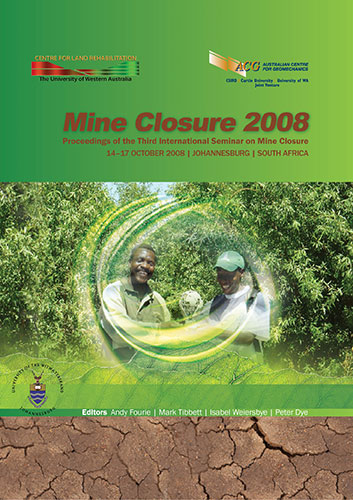Establishing a Framework for Intervention and Remediation of Radioactive Contamination from Gold Mining — Learning from the Past

|
Authors: Ellis, JJ Paper is not available for download Contact Us |
DOI https://doi.org/10.36487/ACG_repo/852_12
Cite As:
Ellis, JJ 2008, 'Establishing a Framework for Intervention and Remediation of Radioactive Contamination from Gold Mining — Learning from the Past', in AB Fourie, M Tibbett, I Weiersbye & P Dye (eds), Mine Closure 2008: Proceedings of the Third International Seminar on Mine Closure, Australian Centre for Geomechanics, Perth, pp. 125-134, https://doi.org/10.36487/ACG_repo/852_12
Abstract:
Over the past number of years, reports by scientific and research institutions, industry specialists, regulators and non-government organizations have raised concerns about radioactive and metal contamination in areas such as the Wonderfonteinspruit Catchment Area (WCA), resulting mainly from diffuse and direct pollution from gold and uranium mining over the last one hundred years. The individual and collective initiatives by the relevant stakeholders to address the mining legacy in areas such as the Wonderfonteinspruit highlighted the importance of: High confidence scientific assessments on the extent and significance of environmental impacts. The optimization of remediation methodologies and programmes to ensure that all actions are justifiable in terms of as low as reasonably achievable (ALARA) principles. The importance of a management framework to ensure the effective engagement of all stakeholders. The aim of this paper is to outline the principles of a framework for intervention and remediation in the WCA using the precedent set, and lessons learnt, from a previous co-operative exercise by the mining industry, the National Nuclear Regulator (NNR) and the public, to clean up thirty-eight off-mine sites. It further incorporates the principles of intervention and a source/pathway/receptor assessment approach.
References:
Coetzee, H., Winde, F. and Wade, P.W. (2006) An assessment of sources, pathways, mechanisms and risks of current
and potential future pollution of water and sediments in gold-mining areas of the Wonderfonteinspruit
catchment, Water Research Committee, Report 1214/1/06.
ICRP (International Commission on Radiological Protection) (1991) Recommendations of the ICRP, Annuals of the
ICRP 21(1.3), Pergamon Press, Oxford, United Kingdom.
ICRP (International Commission on Radiological Protection) (2000) Protection of the public in situations of prolonged
radiation exposure, Pergamon Press, Oxford, United Kingdom.
Jensen, H. (2002) Protection Against Prolonged Exposure – Application In Accident Situations, Nordic Society for
Radiation Protection, 13th Ordinary Meeting, Turku, Finland.
Joubert, A. (2007) Radiological impacts of the mining activities to the public in the Wonderfonteinspruit catchment
area, National Nuclear Regulator.
National Nuclear Regulator (NNR) (2004) Guideline On The Assessment Of Radiation Hazards To Members Of The
Public From Mining And Minerals Processing Facilities, NNR Guidance Document, LG-1032, Revision 1.
National Nuclear Regulator (NNR) (2006) Regulations in terms of Section 36 [read with section 47 of The National
Nuclear Regulator Act, 199 (Act No. 47 of 1999)] on Safety Standards and Regulatory Practices.
NHMRC (National Health and Medical Research Council) (1995) Recommendations for limiting exposure to ionising
radiation, Radiation Health Series, 39, Government Publishing Service, Canberra.
© Copyright 2025, Australian Centre for Geomechanics (ACG), The University of Western Australia. All rights reserved.
View copyright/legal information
Please direct any queries or error reports to repository-acg@uwa.edu.au
View copyright/legal information
Please direct any queries or error reports to repository-acg@uwa.edu.au